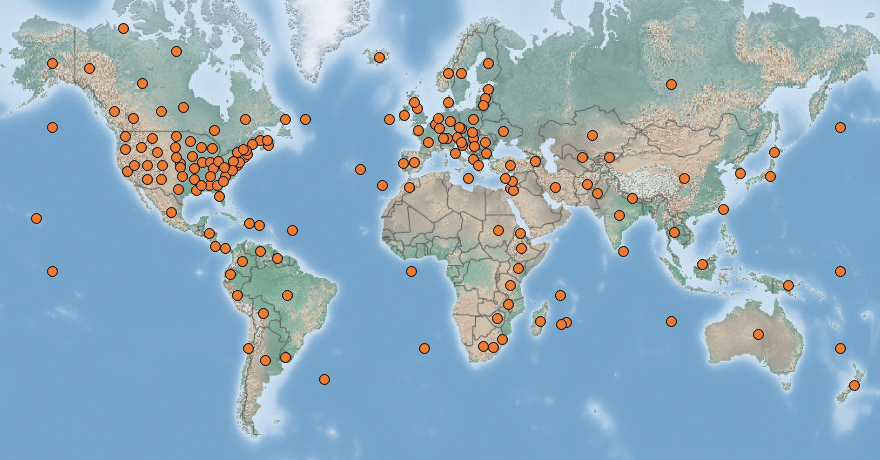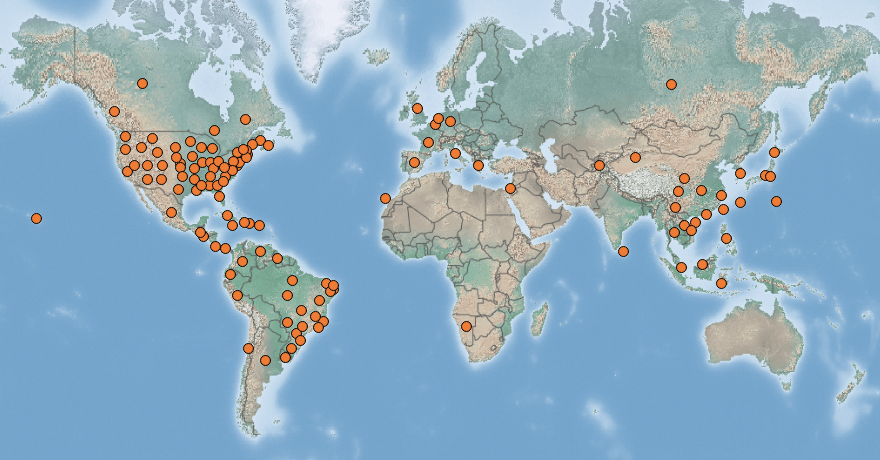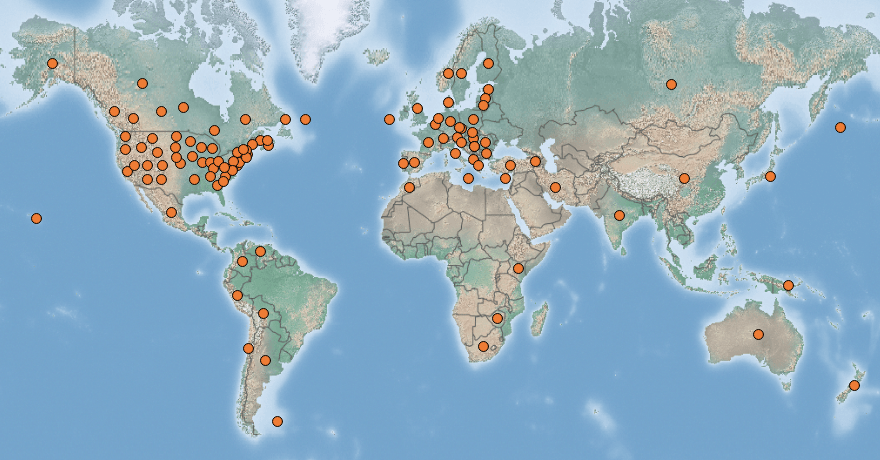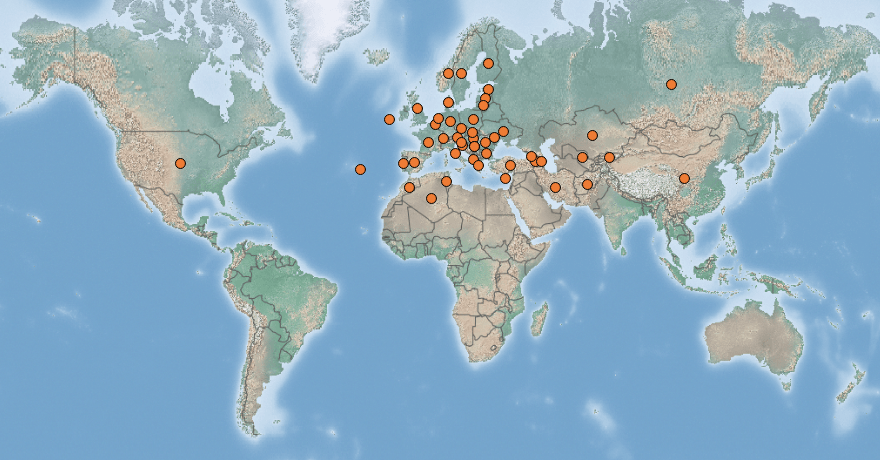 |
Canadian fleabane | Status LU: established. 1st record: LU & ITW 1822. |
 |
Kanadesch Beruffkraut | Status Eur.: established. 1st record: Eur. 1600s. |
 |
Vergerette du Canada | RA: ISEIA: C3. Harmonia+: 0,24 |
 |
Kanadisches Berufkraut | Wikipedia:     | Wikispecies: | Wikispecies:  | CABI | CABI |
 |
Canadese fijnstraal | Back to the list of neophytes |
Contents
Brief description
Conyza canadensis (L.) Cronquist is considered a weed and is associated mostly with perennial crops, fallows and field borders. It also occurs on roadsides and appears as an early successional species on recently disturbed land. This North American species has a high spreading capacity due to its ability to adapt to different environments combined with high reproductive potential and high seed mobility.
Status and distribution in Luxembourg
Records of Conyza canadensis (L.) Cronquist in Luxembourg. Data source: Recorder-Lux, iNaturalist & GBIF, 2025-08-02.
In Luxembourg, Conyza canadensis (L.) Cronquist was first reported in 1822 from a wall in Rollingen, municipality of Mersch (Krombach 1874: 344). In 1836, it was mentioned under its synonym Erigeron canadensis as an annual herbaceous plant which flowers in June-July and colonises dry and sandy environments (Tinant 1836: 424). In 1873, Koltz describes the species as common, but missing in large spaces. Found in rubble, old walls, roadsides, fallow fields around Luxembourg City. Rare in the Ardennes (Koltz 1873: 129). Between 1900-1909 huge populations were observed on the banks of the river Sauer in Diekirch (Robert 2010: 15).
The species was first documented in 1883 in Mersch by Jean Feltgen (1833-1904) (Specimen № 13971 MNHNL 2000-). The next observation was made by Léopold Reichling on 8th August 1952 in Manzenbaach, Municipality of Larochette. Since then, more than 310 observations have been recorded, especially in the central area of Luxembourg, while the north of the country is populated much more sparsely (MNHNL, iNaturalist & GBIF 2019).
According to Lambinon & Verloove (2012), the species is generally common to quite common in the environment, apart from the Ardennes and the Eifel, where it is rare (Lambinon & Verloove 2012: 709). × Conyzigeron huelsenii (Vatke) Rauschert, an intergeneric hybrid between Erigeron acris and Conyza canadensis, is very rarely observed (Lambinon & Verloove 2012: 707).
Risk assessment
ISEIA protocol
C3 (3+2+2+1) (Ries et al. 2013: 18).
Harmonia+ protocol
Overall risk score 0,24 = (Overall Invasion score 0,74 x Overall Impact score 0,31) (Ries et al. 2020).
 Invasion
Invasion0,31

 Impact
Impact0,24

 Risk
RiskWorldwide distribution
Bibliography
- CABI, 2019. Conyza canadensis. In: Invasive Species Compendium. Wallingford, UK: CAB International. URL: www.cabi.org/isc [accessed 2020-02-28]
- Krombach, J.-H.-G., 1875. Flore du grand-duché de Luxembourg. Plantes phanérogames. 564 p. Luxembourg, Imprimerie Joris.
- Lambinon J. & F. Verloove, 2012. Nouvelle flore de la Belgique, du grand-duché de Luxembourg, du Nord de la France et des régions voisines. Sixième édition. Avec la collaboration de L. Delvosalle, B. Toussaint, D. Geerinck, I. Hoste, F. Van Rossum, B. Cornier, R. Schumacker, A. Vanderpoorten et H. Vannerom. Jardin botanique national de Belgique, Meise. CXXXIX + 1195 pp. ISBN : 9789072619884.
- MNHNL, 2000-. Conyza canadensis (L.) Cronquist in Recorder-Lux, database on the natural heritage of the Grand Duchy of Luxembourg. Musée national d’histoire naturelle, Luxembourg. URL: https://mdata.mnhn.lu [Accessed 2019-09-05]
- MNHNL, iNaturalist & GBIF, 2019. Conyza canadensis (L.) Cronquist in MNHNL-mdata, online portal combining species observation from Recorder-Lux, iNaturalist and GBIF. National Museum of Natural History, Luxembourg. URL: https://mdata.mnhn.lu [Accessed 2019-09-06]
- Ries, C. & Y. Krippel, 2021. First records of 56 invasive alien vascular plants in Luxembourg. Bulletin de la Société des naturalistes luxembourgeois 123: 115-127. [PDF 241 KB]
- Ries, C., Y. Krippel, M. Pfeiffenschneider & S. Schneider, 2013. Environmental impact assessment and black, watch and alert list classification after the ISEIA Protocol of non-native vascular plant species in Luxembourg. Bull. Soc. Nat. luxemb. 114: 15-21. [PDF 652 KB]
- Ries, C., Y. Krippel & M. Pfeiffenschneider, 2020 [submitted]. Risk assessment after the Harmonia+ protocol of invasive alien vascular plant species in Luxembourg. Bulletin de la Société des naturalistes luxembourgeois.
- Robert J., 1910. Beiträge zur Flora des Grossherzogtums Luxemburg. lnst. G.-D. Lux., Sect. Sc. natur., phvs., math., Arch. trimestr. n.s. V: 1-35. Luxembourg: Imprimerie de la Cour Victor-Buck.
- Tinant, F. A., 1836. Flore luxembourgeoise, ou, Description des plantes phanérogames, recueillies et observées dans le grand-duché de Luxembourg, classées d’après le système sexuel de Linnée. 512 p. Luxembourg, J. P. Kuborn.
Page content last updated on 2021-03-02. Last proofread by Caroline Grounds on 2019-11-14.




















